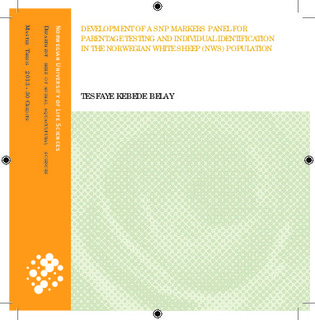| dc.contributor.author | Belay, Tesfaye Kebede Jr | |
| dc.date.accessioned | 2013-08-05T11:15:51Z | |
| dc.date.available | 2013-08-05T11:15:51Z | |
| dc.date.copyright | 2013 | |
| dc.date.issued | 2013-08-05 | |
| dc.identifier.uri | http://hdl.handle.net/11250/186195 | |
| dc.description.abstract | Correct parentage information is essential for the success of livestock breeding programs. However, pedigree errors could occur due to human made errors or unintentional misbreeding due to e.g. a broken fence or similar circumstances. Such errors have large impact on the efficiency of a genetic evaluation of breeding program. DNA based parentage information is therefore crucial in this regard. Based on data from 378 rams genotyped by the ovine Illumina 50K SNP chip, we have generated a highly informative SNP markers panel consisting of 68 markers distributed across 24 autosomes. These markers have 0.48 to 0.5 minor allele frequencies and have been located at ≥20Mbp apart from each other when residing on the same chromosome. Theoretical powers for identity and parentage exclusion of these markers were calculated based on allele frequency data. Practical power of the panel in paternity exclusion or assignment was verified using real data from NWS and Spael breeds. The 68 highly informative markers were also tested for their technical feasibility. Combined probability of identity for the 68 markers was estimated as 1.09x10-29, which increased to 9.81x10-15 when a subset of 33 markers with excellent technical performances (≥95 call rate) was used. The combined powers of parentage exclusion (PE) was calculated, considering the situations where both parents are genotyped but only one parent is evaluated for exclusion (PE1) or both parents are evaluated for exclusion (PE2) and when only parent is genotyped and evaluated for exclusion (PE3). The power was estimated to be 0.999999 (PE1), 1.00 (PE2) and 0.999886 (PE3). The corresponding powers when 40 markers with very good technical performances (≥90 call rate) were used were 0.999753, 0.999998 and 0.995206, respectively. Practically, the panel revealed 4.9% and 13.3% incompatible genotypes for at least one marker of the parent-offspring pairs studied in the NWS and Spael breeds, respectively. Moreover, the panel with 68 markers achieved an overall paternity assignment rate of 97.3%. These results show that the developed SNP marker panel has sufficient power for either paternity exclusion or assignment and for individual identification. Therefore, the results of this study can immediately be used in the parentage testing practice to provide parentage verification and is expected to contribute to the quality control in the NWS breeding system. | no_NO |
| dc.language.iso | eng | no_NO |
| dc.publisher | Norwegian University of Life Sciences, Ås | |
| dc.subject | Individual identification | no_NO |
| dc.subject | Norwegian White Sheep | no_NO |
| dc.subject | Parentage testing | no_NO |
| dc.subject | Single nucleotide polymorphism | no_NO |
| dc.title | Development of a SNP markers panel for parentage testing and individual identification in the Norwegian White Sheep (NWS) population | no_NO |
| dc.type | Master thesis | no_NO |
| dc.subject.nsi | VDP::Agriculture and fishery disciplines: 900::Agriculture disciplines: 910::Livestock breeding, rearing, reproduction: 912 | no_NO |
| dc.source.pagenumber | 51 | no_NO |
